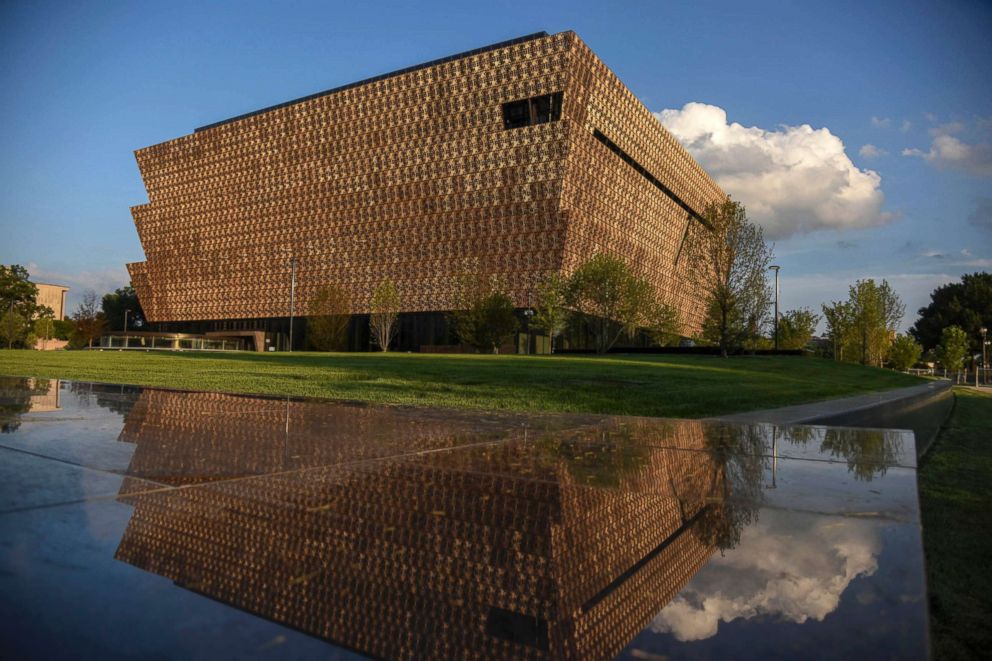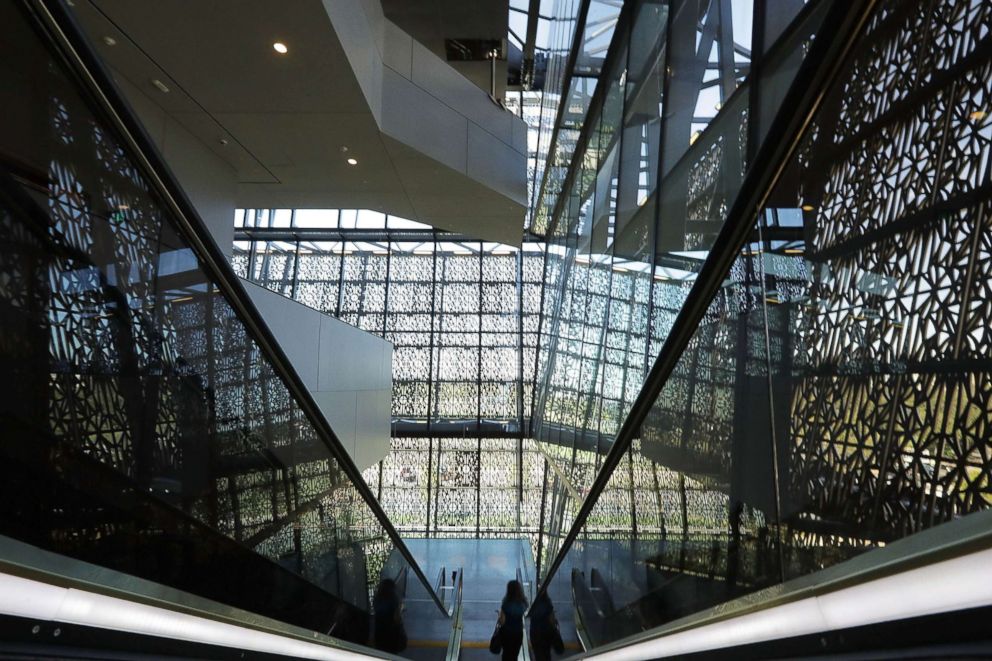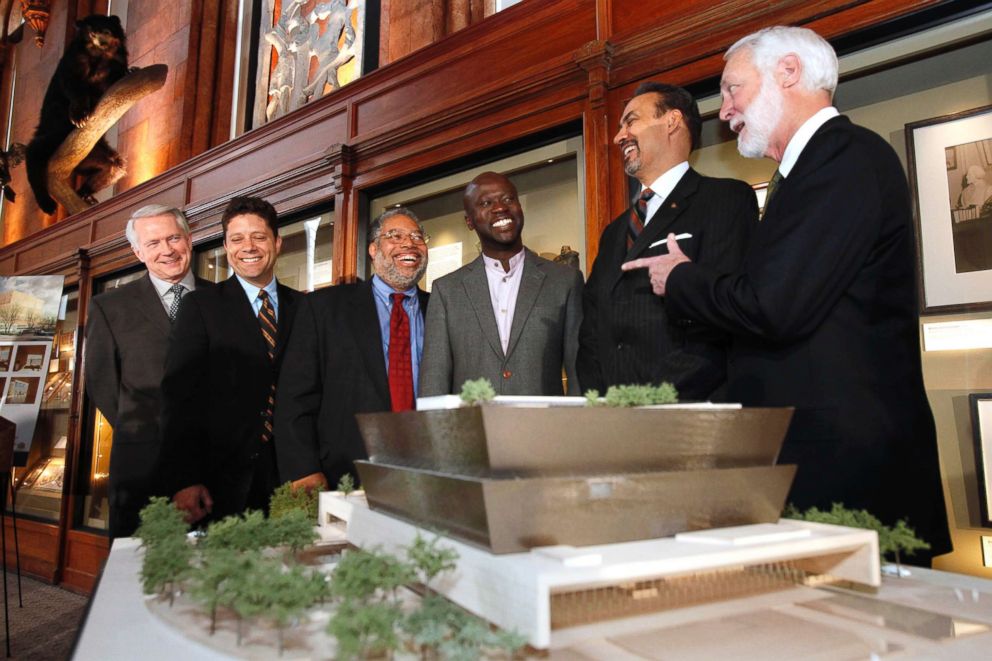The legacy of America’s most prominent black architect, Phil Freelon

This story originally appeared on The Undefeated.
It was a brisk early afternoon in January, and I was sitting in a van in Durham, North Carolina, with Phil Freelon, arguably the most prominent working African-American architect in the country. Freelon is best known for designing the National Museum of African American History and Culture and other major museum projects — among them Atlanta’s National Center for Civil Rights, San Francisco’s Museum of the African Diaspora, and Charlotte’s Harvey B. Gantt Center for African-American Arts + Culture. But on this day, we were admiring, of all things, a bus station.
“If you go around the country and visit bus stations, they’re usually seedy and dirty,” he said. “But they don’t have to be.”
And the Durham Station Transportation Center, which Freelon designed, wouldn’t be out of place on the gilded campuses of Apple or Google. The center, which opened in 2008, has a glass exterior topped by a sleek metal roof sloped like a beret, covering an airy, minimalist interior lounge and ticketing area.
“In my career, I’ve learned that if you build something beautiful, people will respect it,” he said. “You’ll notice there’s no graffiti. Now, I don’t think everyone going to catch a bus looks around and says, ‘Wow, this is a beautiful building.’ But I think they soak in the ambiance, and I’m happy about that.”
The paradox of architecture is that it’s all around us, and yet, for many people, the profession remains esoteric. “If you have a talented young African-American, their family will likely know a lawyer, doctor, teacher or a clergyman, but not an architect,” Freelon said. “My parents, who were both college-educated, didn’t know an architect of any color, and certainly not a black one.
“Diversity is a huge problem in our profession. The profession is small — there are only 110,000 licensed architects in the United States, compared to 1 million attorneys and 800,000 physicians. And only 2 percent of architects are African-Americans, a lower ratio than with lawyers and doctors.”
Freelon, 65, has attempted to change that on several fronts: through his hiring practices, visits to predominantly minority schools to speak about his work, and the establishment in 2016 of the Freelon Fellowship, which provides financial aid so a student from an underrepresented group can attend the Harvard Graduate School of Design. And since he founded his eponymous firm in 1990, much of his work has been focused on designing libraries and other academic buildings for historically black colleges and universities and cultural projects in traditionally black neighborhoods.
Currently he’s involved with a major expansion of the Motown Museum in Detroit, a mile-long open-air museum along Crenshaw Boulevard in Los Angeles and the North Carolina Freedom Park in downtown Raleigh. “He’s designed nearly every major museum or public space dedicated to black culture in the United States,” Fast Company magazine observed when it named Freelon its Architect of the Year in 2017.
“Of course, you don’t just wake up one morning and the Smithsonian wants you to build a museum,” Freelon said. “There’s 30 years of work that leads up to that.”
Before he had ever met an architect, Freelon had decided to become one. He grew up in Philadelphia, where his mother was a school administrator and his father was a salesperson for Cordis, a Miami-based medical device manufacturer. Freelon attended Central High School, an academically rigorous, predominantly white, all-boys magnet school, which also produced the famed architect Louis Kahn. Citing the influence of his grandfather, Allan Randall Freelon Sr., a Harlem Renaissance-era painter, Freelon said he was drawn to classes in the visual arts, as well as drafting and design. He also took inspiration from his strolls through the city, visiting the Franklin Institute and the Philadelphia Museum of Art. “Only later,” Freelon said, “did I learn that a black architect, Julian Abele, helped design the museum,” including the iconic steps featured in Rocky.
Freelon had his mind set on attending a historically black college or university (HBCU) and enrolled at Hampton University in Virginia. “It was the height of the civil rights movement and Black Power, and I had an Afro and was very socially engaged,” he said.
Freelon plowed through the curriculum. “He was an excellent student, meticulous and curious,” said John Spencer, chairman of the architecture department, whom Freelon credits as his first mentor. Believing he would be more challenged at a larger university, Freelon transferred to North Carolina State, although he was anxious about moving deeper into the South. “When my father used to attend his company’s annual conference in Miami in the ’60s, he couldn’t stay in the downtown hotels and would stay in the black neighborhood of Overtown,” Freelon recalled. But a visit to Raleigh reassured him.
“At N.C. State, Phil and I were two of only a handful of black students at the College of Design, and there weren’t any black professors in our discipline,” recalled Percy Hooper, now an associate professor of industrial design at N.C. State. “We didn’t feel segregated from the white students, but we ended up spending a lot of time together, supporting one another.” The coursework was demanding, and there wasn’t a lot of downtime. To unwind, the friends would ride their bikes or, more ill-advisedly, toss around ninja stars.
During summers, Freelon worked for a professor at the Durham-based architectural firm of John D. Latimer and Associates and continued at the firm’s Taunton, Massachusetts, office while pursuing a master’s degree at MIT, which he completed in 1977. He worked briefly for a large firm, 3/D International in Houston, before returning to Durham to join O’Brien Atkins Associates, where he soon became the firm’s youngest partner.
Freelon helped design schools, churches and other buildings around the state. “As a young architect, you’re not a specialist and you tackle a wide variety of projects.” A significant step in his career, he said, was being tapped as lead designer for Terminal 2 of the Raleigh-Durham International Airport. “Of course, it’s since been demolished and rebuilt,” he said, chuckling. “At this stage of my career, there are a few buildings that I’ve designed that have been torn down.” (He later designed an award-winning parking garage at the airport, as well as the airport’s general aviation building.)
In 1989, Freelon received a fellowship to study independently for a year at Harvard. The next year, he left O’Brien Atkins to launch his own firm, the Freelon Group. It began as a one-man shop and grew to more than 50 employees, about 40 percent of whom are women and 30 percent people of color.
“When I decided to start my own practice, I had a pretty good idea of what I wanted to do and not do,” Freelon said. “I wasn’t going to design prisons, strip malls or casinos. The work that excited me were schools, libraries and similar projects that positively impacted the community.” Freelon also said he had little interest in upscale residential projects, the multimillion-dollar homes that fill the pages of Dwell and Architectural Digest, the ubiquitous coffee table magazines of the aspiring bourgeoisie. “The only home I’ve ever built is my own,” he said.
One afternoon, I joined Freelon and his wife, Nnenna, at their suburban home, a 15-minute drive from downtown Durham. The modern, two-story structure with a matching separate studio space features a warm combination of concrete, steel, glass and laminate siding. The sloped lot abuts a pond and runs the length of a football field. There’s a long path from the house to a fire pit and a steel animal sculpture that the Freelons named Kareem Abdul-Giraffe.
Inside, the New Standard Quintet, a Chicago jazz group, played on the stereo while the couple’s dog, Count Basie, perched by the couch. Earlier, Freelon had told me how he met his wife. Nnenna, a Massachusetts native, was finishing her undergraduate degree at Simmons University in Boston. She was on a visit to the University of North Carolina, Chapel Hill, where she was considering pursuing a graduate degree in health care administration. A mutual friend introduced them. “We met on our friend’s front porch, and for me it really was love at first sight,” Phil Freelon said. It was a swift courtship. With only her undergraduate thesis to complete, Nnenna moved to North Carolina, they got married and she quickly became pregnant. She put graduate school on hold and eventually turned to her first love, jazz singing, and is now a six-time Grammy Award nominee.
“Phil is one of those lucky people who always knew what he wanted to do,” Nnenna Freelon said. “For most of us, it’s more circuitous. I was blessed to have a husband who was passionate about what he did and wanted me to find what I was passionate about.”
For a globe-trotting professional singer and star architect, Durham isn’t an obvious home base. Why not New York, Los Angeles or Chicago? “When you have kids, your life changes,” Phil Freelon said. “We figured we could live here and get in an airplane and go where we needed to go. I’m a huge family guy, and I love being a father. That was most important.” The Freelons have three children, who all live nearby. Deen Freelon, the oldest, is a tenured professor at the UNC School of Media and Journalism. Maya Freelon Asante is a visual artist. And Pierce Freelon, the youngest, is an activist and former Durham mayoral candidate who runs Blackspace, an after-school entrepreneurship and social media program for disadvantaged youths.
“It’s been impressive what Phil has done here,” said Kevin Montgomery, the African-American president of O’Brien Atkins whom Freelon recruited to that firm in 1988. “He was able to develop a firm in a midsize market that has global recognition and can compete with much larger firms in places like New York and Chicago.”
That proved to be the case with the Smithsonian museum, a project, Freelon said, that was more than a decade in the making. A couple of years after his Museum of the African Diaspora opened in 2005 in San Francisco, Freelon teamed up with New York’s Max Bond to win a contract from the Smithsonian to complete the planning and pre-design work for the African-American museum on the National Mall. A year later, the Smithsonian announced an international design competition, and Ghanaian-British architect David Adjaye approached Freelon and Bond about joining forces.
“David is the highest-profile architect of African descent in the world, and we had our eyes out for what he was going to do for the competition,” Freelon said. “We met and determined we had similar approaches and values, so the team was expanded.” They also added another firm, Washington-based SmithGroup, which had previously done work for the Smithsonian. More than 60 groups, representing firms throughout the world, sought the commission. The Smithsonian eventually culled the field to six, provided them with stipends and asked them to produce designs within 60 days.
“We were competing against all these starchitects,” Freelon said, including I.M. Pei, Norman Foster and Moshe Safdie. A committee composed of members of the Smithsonian, the architectural press and academics picked the Freelon Adjaye Bond/SmithGroup design.
When the National Museum of African American History and Culture opened in 2016, Los Angeles Times architecture critic Christopher Hawthorne hailed the building’s “powerful strangeness” that “embraces memory and aspiration, protest and reconciliation, pride and shame.” He continued, “The museum’s skin — has that typically benign architectural term ever been more charged? — allows it to stand apart from the Mall’s white-marble monuments like a rebuke.” The most recent accolade came in January, when the American Institute of Architects named the museum one of nine winners of its 2019 Honor Awards.
During the opening ceremonies, which included a Kennedy Center performance by Nnenna, Freelon was walking with a cane. He’d experienced leg troubles the previous year, although at first he didn’t think much of it. “I was run-down anyway, because 2015 was an intense year,” he said. Not only was he finishing the museum, he was also teaching at MIT. He had also just completed a merger of his firm with the global architecture powerhouse Perkins + Will, which had been courting Freelon for more than a decade. Freelon now oversaw the firm’s North Carolina operations from Durham.
“It wasn’t just that Phil was a superstar — and he really is the Michael Jordan of architecture,” said Perkins + Will CEO Phil Harrison. “We wanted Phil because of his design sensibility, which is modern but not cold. There’s a real humanism you can see in all his work. And with his staff you see a real diversity, not just in demographics but in thinking.”
When Freelon traveled to D.C., he would jog around the Mall to stay in shape. “I noticed I’d use the same effort, but it was taking me longer and longer to complete my course, and my right foot was dragging.”
After meeting with several doctors, Freelon was referred to Richard Bedlack, who heads Duke University’s Amyotrophic Lateral Sclerosis Clinic. Freelon was diagnosed with ALS, commonly known as Lou Gehrig’s disease, which is progressive and incurable. It attacks the nerve cells in the brain and spinal cord and in time results in total paralysis and, ultimately, death — typically within two to four years after the diagnosis.
Freelon was “shocked and disappointed,” he said, and there was a brief period of denial. But after a few months, Freelon told his staff and took a month off to ponder his future. “But I decided to go back and work full time,” he said. Now, he uses a heavy electric wheelchair and works less and mainly from home. He remains on the Perkins + Will board of directors and is closely involved in ongoing projects.
“I’m an optimist by nature, and I look at my prognosis as a glass half full,” Freelon said. “I’m relieved I was able to raise my children and have a career and family.”
One can drive a mile in almost any direction around Durham and come across a building Freelon designed. With his sister-in-law Debbie Pierce driving Freelon’s customized van, we visited the Durham Bulls’ Athletic Park, home to the country’s most famous minor league baseball team featured in the movie Bull Durham; the Durham County Human Services Building, an airy, glass structure with a huge courtyard that replaced a grim, Soviet-style bureaucratic bunker; and several science buildings on the campuses of North Carolina Central, an HBCU, and Duke University.
Few professions offer their practitioners a chance to leave a physical legacy, and I offered to Freelon that he must feel proud as we revisited his creations. He laughed and alluded to a famous Frank Lloyd Wright quote: “A doctor can bury his mistakes, but an architect can only advise his clients to plant vines.”
Of course, Freelon didn’t view his works as mistakes. He was being self-deprecating. But it was also significant that on our tour he insisted I visit a few buildings he didn’t design.
We parked in front of Duke University Chapel, a majestic Gothic structure with a 210-foot-tall bell tower. The chapel, along with other significant structures on Duke’s campus, including Cameron Stadium, was designed by Julian Abele, an African-American architect who was the chief designer for the Philadelphia firm of Horace Trumbauer. “The story goes that when Abele came down here to do site work he had to dress up in overalls and pretend he was a common laborer or he wouldn’t have been allowed on campus,” Freelon said. It wasn’t until the 1980s that the university formally acknowledged Abele’s contributions, placing a portrait of the architect in the lobby of the main administration building and naming the main campus quad Abele Quad.
Later, we pulled in front of a small church in a historically African-American neighborhood. Opened in 1931, it was originally a church for the deaf, who were recruited to work in Durham’s noisy cigarette manufacturing plants. More recently, it had been rented to various congregations. Eventually, it was put up for sale and Phil and Nnenna Freelon purchased it. We went inside, where workers were renovating the space. Freelon had hired a friend who had more experience with such work to be the architect.
The Freelons created a nonprofit, North Star Church of the Arts, to operate the building as a community space. (An inaugural service will be held Feb. 17.) “We’ll have spoken-word nights, after-school programs, maybe some weddings and other ceremonies,” Freelon said. “We just want to give back to the community.”
We were in the back of the church. The pews had been pulled out and stacked to the side, and we looked toward an imaginary dais.
Freelon has been involved in building celebrated structures that will last for many years. The Smithsonian museum likely will survive as long as our republic. But here he was inside a humble church that he didn’t even design, smiling. “Nnenna and I wanted this to be our legacy project,” he said.
Source: Read Full Article


